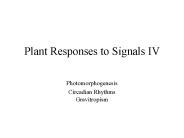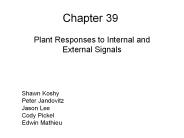Statolith PowerPoint PPT Presentations
All Time
Recommended
A COMPOUND PRODUCED BY ONE PART OF AN ORGANISM THAT IS TRANSPORTED TO OTHER ... FALLING STATOLITH HYPOTHESIS. STATOLITHS MAY ENHANCE GRAVITATIONAL SENSING IN PLANTS ...
| PowerPoint PPT presentation | free to view
Animal Kingdom Pt 3 Dr. James Whitfield
| PowerPoint PPT presentation | free to view
Fig. 7-0a - Estrella Mountain Community College
| PowerPoint PPT presentation | free to download
Title: APPENDAGES CRUSTACEA Author: Kartono Last modified by: User Created Date: 3/23/2005 2:42:50 PM Document presentation format: On-screen Show (4:3)
| PowerPoint PPT presentation | free to download
Plant Responses AP Biology Chapter 39
| PowerPoint PPT presentation | free to view
Photoperiodism, Gravitropism, and Thigmotropism AP Biology Unit 5 Photoperiodism How a plant responds (with respect to flowering) to the relative amount of light ...
| PowerPoint PPT presentation | free to view
Presenting Professional Talks J. Ellen Marsden Rubenstein School of Environment and Natural Resources University of Vermont http://www.uvm.edu/rsenr/nr385proskills/
| PowerPoint PPT presentation | free to view
Title: Concept Map Author: Jeff Young Last modified by: Jeff Young Created Date: 12/1/2003 8:28:31 PM Document presentation format: On-screen Show Company
| PowerPoint PPT presentation | free to download
Chapter 38 Angiosperm Reproduction Angiosperms have 3 unique Features: Flowers Fruits Double Fertilization (by 2 sperm) REPRODUCTIVE VARIATIONS Pollination: transfer ...
| PowerPoint PPT presentation | free to view
... natural auxin in plants Promotes elongation & secondary growth Apical meristem is the major site of auxin production Inhibits lateral growth Induces female ...
| PowerPoint PPT presentation | free to download
7 .
| PowerPoint PPT presentation | free to download
Ch. 39 Warm-Up Elaborate on the ... Signals Experiments with Light and the coleoptile Excised tip placed on agar block Growth-promoting chemical diffuses into agar ...
| PowerPoint PPT presentation | free to download
Sensory Receptors
| PowerPoint PPT presentation | free to download
Title: video Author: BCP User Last modified by: Sally Created Date: 7/11/2002 5:04:39 PM Document presentation format: On-screen Show (4:3) Company
| PowerPoint PPT presentation | free to download
Plant Hormones Plant tropisms Growth in a particular direction in response to an external stimulus Early experiments Canary grass coleoptiles Classes Hormones Five ...
| PowerPoint PPT presentation | free to view
Nematocysts: More firearm than syringe? Study sequenced mediterrean jellyfish, Rhopilema nomadica venom. Identifed unique mechanical ...
| PowerPoint PPT presentation | free to download
graph of the magnitude of a biological response to light, as a ... FR. light. Phytochrome. photoreceptor molecule. Quantity, Time, Quality. Phytochrome Location ...
| PowerPoint PPT presentation | free to download
Control Systems in Plants. Plant Hormones. What is a Plant hormone? ... Plants synthesize Pr in dark. if phytochrome illuminated then Pr---Pfr ...
| PowerPoint PPT presentation | free to view
Ablate columella cells and root will still grow ' ... Columella Cells ... Laser ablation of columella cells doesn't completely remove gravity response ...
| PowerPoint PPT presentation | free to view
... Chapter 25: Plant Responses to the Environment Plant Hormones: 4) Ethylene ... Plant Responses to the Environment Hormonal Regulation of Plant Life Cycle: ...
| PowerPoint PPT presentation | free to download
Chapter 39 Plant Responses to Internal and External Signals Shawn Koshy Peter Jandovitz Jason Lee Cody Pickel Edwin Mathieu Gravity Gravitropism is a response to gravity.
| PowerPoint PPT presentation | free to download
erf: ethylene response factor. no transcription. Light is used by plants as a signal, as well as an energy source, ... Explain the importance of auxin in plants. ...
| PowerPoint PPT presentation | free to download
Caused by elongation (from auxin) of cells on shaded side ... Thigmotropism. Response to contact with a solid object. Navigate, wrap around objects (tendrils) ...
| PowerPoint PPT presentation | free to view
Plant Growth Regulators AKA Plant Hormones Plant Growth Regulators - control growth, development and movement
| PowerPoint PPT presentation | free to view
Discovery of Plant Hormones. Classes of Plant Hormones. Auxins. Cytokinins. Gibberellins ... long-day plant flowers when daylength increases ...
| PowerPoint PPT presentation | free to view
Cytokinin sprays can help to keep cut flowers fresh. They delay aging by inhibiting protein breakdown, and stimulating RNA and protein synthesis.
| PowerPoint PPT presentation | free to view
1 High cytokinin/auxin ratios favor the formation of shoots. 2 Low cytokinin/auxin ratios favor the formation of roots. Senescence ...
| PowerPoint PPT presentation | free to view
Plant Responses to Internal and External Signals Plant Hormones Plant Movements Control of Daily and Seasonal Responses Phytochromes Plant Hormones Hormone-compound ...
| PowerPoint PPT presentation | free to view
... meristem and is found in young leaves and in flowers and fruits ... or flower to drop ... require a specific sequence of day lengths in order to flower ...
| PowerPoint PPT presentation | free to download
Plant Response to Stimuli Stimuli and a Stationary Life Plants, being rooted to the ground Must respond to whatever environmental change comes their way For example ...
| PowerPoint PPT presentation | free to view
... on the lighted side Light destroys auxin Light drives auxin to the shaded side Light eliminates auxin activity Tropism video Thigmotropism is growth ...
| PowerPoint PPT presentation | free to download
Skin Senses: Touch, Haptics, Nociception, Vestibular System Receptors The receptor cells in the skin are (mostly) called mechanoreceptors, and transduce mechanical force.
| PowerPoint PPT presentation | free to download
insects, crayfish, crabs. single-lens eyes. Work like a camera. ... Common in jellyfishes, snails, squids, crayfishes & earthworms. 2. Vertebrate Mechanoreception ...
| PowerPoint PPT presentation | free to view
Chapter 28 External factors and Plant growth Nastic Movement Nastic Movements- plants movement that occur in response to a stimulus independent of position of ...
| PowerPoint PPT presentation | free to download
Plant Responses to Abiotic Environment Biological orientation of plants Tropisms: when growth toward stimulus it is positive and vice versa. Taxes: occur in algae ...
| PowerPoint PPT presentation | free to view
Title: Slide 1 Author: MARTIN HUSS Last modified by: MHUSS Created Date: 4/12/2006 10:58:09 PM Document presentation format: On-screen Show Company
| PowerPoint PPT presentation | free to view
Vibration on oval window causes vibration of perilymph (fluid) in the cochlea ... 1. Age-related hearing loss in humans -gradual loss in the ability to hear ...
| PowerPoint PPT presentation | free to view
Chapter 39: Plant responses to internal & external signals Plants= sessile must respond to environmental changes/cues by adjusting patterns of growth & development
| PowerPoint PPT presentation | free to view
... (stimulate chemoreceptors) Electromagnetic/thermal energy (stimulate photoreceptors ... 4-5 cones see near ultra-violet light Many mammals have only 2 ...
| PowerPoint PPT presentation | free to download
Figure 36.0 Eucalyptus trees Figure 36.1 An overview of transport in whole plants (Layer 3) Figure 36.1 An overview of transport in whole plants (Layer 4) Figure 36.2 ...
| PowerPoint PPT presentation | free to view
dormancy during winter. flowering at appropriate times ... Seed dormancy = mechanism to protect seed from germinating during unfavorable conditions ...
| PowerPoint PPT presentation | free to view
Photoperiodism flowering times, Long-day plants, night breaks induce flowering. Short-day plants, night breaks inhibit flowering.
| PowerPoint PPT presentation | free to download
Neurophysiology, Muscular
| PowerPoint PPT presentation | free to download
Floor of the cochlear duct is the basilar membrane ... located on the basilar membrane, with hair cells ... Sound waves cause the basilar membrane to vibrate. ...
| PowerPoint PPT presentation | free to view
Chapter 39 Plant Responses to External and Internal Signals
| PowerPoint PPT presentation | free to download
flower initiation. sex determination. fruit development. Control ... Promotion of flowering. Transport is non-polar, bidirectional producing general responses. ...
| PowerPoint PPT presentation | free to view
Division: Cycadophyta Cycads are vascular, seed plants that are palm-like and are called Sago Palms. The leaves are found in a cluster at the tops of the trunks.
| PowerPoint PPT presentation | free to download
chapter 7 radiate animals cnidarians and ctenophores 7-*
| PowerPoint PPT presentation | free to download
Abscisic Acid Slows or inhibits plant growth.
| PowerPoint PPT presentation | free to view
Chapter 32 Plant Growth and Development * * * * * * * * * * * * * * * * * * * How Do Seeds Germinate? Germination is the resumption of growth after a time of arrested ...
| PowerPoint PPT presentation | free to view
Having 2 copies of each chromosome enables mutations to exist without resulting ... branches and trunks from the vascular cambium puts a new layer of secondary ...
| PowerPoint PPT presentation | free to view
Sound waves in air travel through outer ear until they reach tympanic membrane ... inner ear has small calcium carbonate particles called otoliths ...
| PowerPoint PPT presentation | free to view
Plant Responses to Internal and External Signals Chapter 39 Chapter 39 Response to stimuli Plants, being rooted to the ground must respond to whatever environmental ...
| PowerPoint PPT presentation | free to view
Look at a longitudinal and cross section of a carrot (Daucus) root and be able to identigy the following structures: Cortex, stele, pericycle and lateral roots.
| PowerPoint PPT presentation | free to download
Chapter 50 Sensory and Motor Mechanisms * * Figure 50.30 Exploring: The Regulation of Skeletal Muscle Contraction * Figure 50.30 Exploring: The Regulation of Skeletal ...
| PowerPoint PPT presentation | free to view
... have unisexual flowers can either be monoecious or dioecious if staminate and ... flowers are on same plant, then are mono; if on separate plants, then dioecious ...
| PowerPoint PPT presentation | free to view
























































